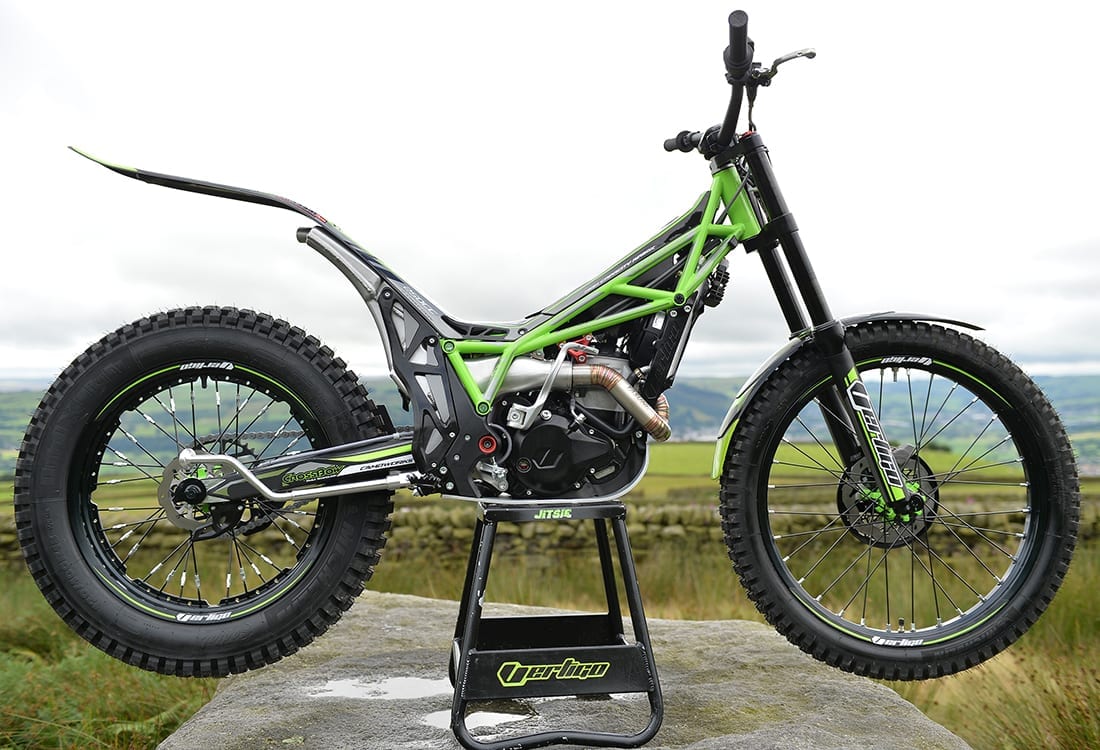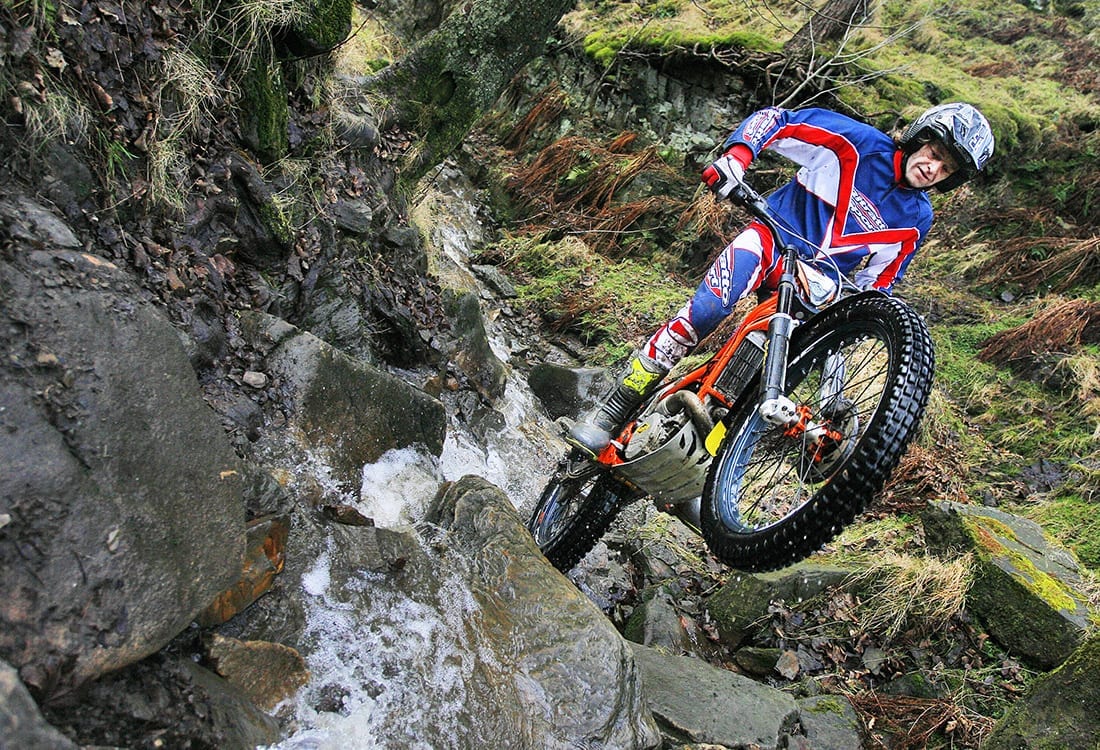On Test - 2017 Vertigo Combat Camo
By John Dickinson on 28th Sep 16

Although the Vertigo marque seems to have been around the trials scene for quite a while now, mainly thanks to Dougie Lampkins two Scottish Six Days victories and James Dabills British Championship, the first test of actual production machines only took place in April this year!
Even then, only 300cc engines were available because that was all the all-new Barcelona factory had had either the time or resources to develop. But both the Camo (standard) and Ice Hell (Factory) were available and both have been coming through for eager customers.
And now, just five months later, Vertigo have already unveiled an updated 2017 model including a 250 - which is already in production and an initial batch has already been delivered. This is big news as the 250 is seen as being a volume selling model for the marque.
Obviously with such a new project there are no radical changes but you do get the latest spec Tech forks and graphics that bring out the best in the design.
A quick recap: The Combat, like the up-specced Ice Hell and the incredible Titanium R, sports a space-type tubular steel chassis a first for a production trials model that utilises a rigid aluminium rear sub-assembly. The latest all aluminium Tech forks are fitted up front with a Reiger shock at the rear, controlling a neat-looking aluminium swinging arm via a conventional linkage system.
The all new electronically fuel-injected (efi), six speed, two-stroke engine sits in the chassis and the fuel tank now transparent - nestles behind, wrapped round the rear shock. This keeps the centre of gravity and centre of mass impressively low and the balance of the machine doesnt alter as the fuel level drops.
One change from standard practise is the introduction of a remote, electrically operated coolant pump. This only draws power from the engine when needed and is also out of harms way mounted behind the cylinder keeping the crankcases width to a minimum. Aiding engine cooling is a unique v-shaped radiator, that has been re-worked, for maximum heat dissipation.
The air-filter sits high over the engine, right out of the water and mud and is very easily accessed, almost ironic as with this layout you have less need to
The really clever stuff is obviously the ECU and associated sensors which allow total control of both ignition and fuel injection for ultra-fine tuning. The rider has the option of four different maps to choose from in each of the six gears. Theres a base standard setting and then variations to suit different conditions or riding style. A simple press of a button is all it takes to switch maps.
Apart from these applied technologies, the Vertigo follows standard practise. Suspension, wheels, brakes, bars, levers etc are all the tried and tested ancillaries that we are all familiar with.
TMX tester WOODY HOLE has ridden just about everything there is to ride and did the honours on the original 300 so we sent out the call when the very first 250 arrived and he was keen as ever to get it on. Vertigo UK had literally opened up the box and added petrol and there wasnt as much as a scratch on the 2017 Camo 250
Said Woody: First up, compared to the 300 which we tested in April the Vertigo somehow looks a more finished product. Its hard to put your finger on why exactly but the graphics are much crisper and more modern and the factory just seem to have gone up a notch.
After a good look round it is difficult to pick fault, Vertigo has been an all-new, ground-up project so there are no compromises and everything is in its place. I like the see-through fuel tank, no more guessing how much juice you have left.
I was reminded that to start the bike you have to press a button which turns on a battery to excite the ECU. The battery is self-charged from the generator. If you stop the engine for 20 seconds it switches off so effectively you press the button for each start. This soon becomes second nature and starting is as simple as that push the button, then kick it over.
Theres no fiddling to find a choke lever and once running theres no loading-up and you can leave the motor ticking over at any angle and there is no petrol spilling out of float bowls and the engine runs ultra clean.
There are four maps to choose from and they do make a considerable difference. This is because the electronics control fuel and ignition so can make significant change. The standard setting is ONE. Press the map button and a light blinks twice, this is mode TWO, repeat for modes three and four.
Like on the 300, mode two richens the mixture and is softer power, mode three is softer again. Then, four leans things off considerably and you have a seriously quick motor.
You can play with this as much as you like but In reality the standard setting ONE is best for most riders most of the time. That really is why it is the standard setting!
The 250 is really the model that should suit most riders. The power is really soft and forgiving and while the 300 isnt an animal, I just felt I could ride the 250 all day. It is much easier on your arms and it is the bike Id choose, it would be perfect for the Scottish.
It might be lovely soft power but dont think it is lacking in poke should you want it because it isnt, theres more than enough go for any real-life situation.
Like on the 300 I loved the six speed gearbox. The bottom four are all usable in sections with fifth for tracks and moors and sixth for road cruising, stanadard practise for a six-speeder. The really impressive bit though is the really short throw of the gear lever and how positive gear selection is. The feel is so positive and theres never any need to worry if the gear is engaged. It is.
The clutch also is just how I like it. It is light to use and while definitely not an on-off switch it bites cleanly and crisply for a swift take-off or attacking steps.
The suspension was amazingly supple for an out of the box bike. Usually you expect forks and the rear unit to bed-in after a couple of hours use but the Tech forks and rear Reiger felt ready to trial straight off.
With really plush action at both ends you are good to go and everything worked a treat. As with all new bikes the riding position was spot on and the 250 felt really stable between the legs. there is something to grip without it being too wide and the bike feels really planted. Maybe not as lively as some but absolutely rock steady in the section.
I understand fully why Vertigo initially concentrated on the 300 model, to get results up at the sharp end of competition, World and National Championships, but the 250 is most definitely the model for the mass market. This is an important model for Vertigo sales.
